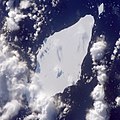Fichier:Iceberg A22A, South Atlantic Ocean.jpg

Taille de cet aperçu : 800 × 530 pixels. Autres résolutions : 320 × 212 pixels | 640 × 424 pixels | 1 024 × 678 pixels | 1 280 × 848 pixels | 2 345 × 1 553 pixels.
Fichier d’origine (2 345 × 1 553 pixels, taille du fichier : 793 kio, type MIME : image/jpeg)
Historique du fichier
Cliquer sur une date et heure pour voir le fichier tel qu'il était à ce moment-là.
| Date et heure | Vignette | Dimensions | Utilisateur | Commentaire | |
|---|---|---|---|---|---|
| actuel | 22 mars 2013 à 17:25 |  | 2 345 × 1 553 (793 kio) | Julian Herzog | Higher resolution and quality |
| 5 juillet 2009 à 21:54 |  | 1 000 × 1 000 (376 kio) | Originalwana | {{Information |Description={{en|1=This astronaut photograph illustrates the remains of a giant iceberg—designated A22A— that broke off Antarctica in 2002. The iceberg was photographed at a location of 49.9 degrees south latitude, 23.8 degrees west lon |
Utilisation du fichier
Aucune page n’utilise ce fichier.
Usage global du fichier
Les autres wikis suivants utilisent ce fichier :
- Utilisation sur ar.wikipedia.org
- Utilisation sur az.wikipedia.org
- Utilisation sur bn.wikipedia.org
- Utilisation sur cy.wikipedia.org
- Utilisation sur en.wikipedia.org
- Utilisation sur eo.wikipedia.org
- Utilisation sur it.wikipedia.org
- Utilisation sur it.wikibooks.org
- Utilisation sur it.wikiversity.org
- Utilisation sur la.wikipedia.org
- Utilisation sur mk.wikipedia.org
- Utilisation sur pt.wikipedia.org
- Utilisation sur sl.wikipedia.org
- Utilisation sur ta.wikipedia.org
- Utilisation sur ta.wiktionary.org
- Utilisation sur th.wikipedia.org


